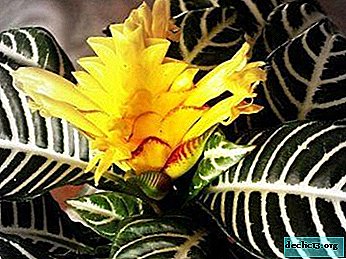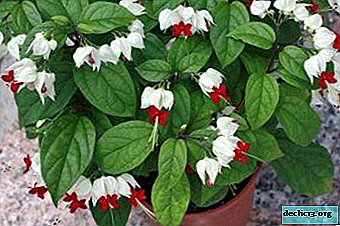Indoor plant Afelander protruded: description, care, reproduction and disease of the flower

Afelandra protruding - a wonderful guest from South America. Thanks to her unusual beautiful leaves and flowers, she firmly won the location of many gardeners.
But this exotic beauty is a rather capricious plant, requiring particularly careful and thorough care at home. After all, any mistake in its content can lead to falling leaves and flowers, and sometimes even to the death of the plant. In this article we will talk about this beautiful flower.
Description of the appearance and characteristics of the flower
The protruding Afelander comes from the Acanthus family. Its native land is Mexico. In Russia, this is the most popular plant of Afelander, grown indoors. Another name is squarrosa.The leaves of this oval-elliptical flower are very large, about 20-30 cm long. They are located opposite. The upper glossy side of the leaf plate is dark green. On its surface, pronounced silver-white stripes symmetrically located along the middle and lateral veins, creating a clear white ornament. The lower side of the leaves of the plant is in a lighter tone.
Two-lipped tubular flowers of Afelandra are collected in apical spike-shaped 30 centimeter inflorescences of a quadrangular shape. These interesting species of light yellow flowers are surrounded by bright orange bracts.
The plant blooms from May to November. Faded inflorescences are recommended to be cut.
Household conditions and care
Lighting
This Mexican beauty loves bright, but not excessive lighting. If you place the flower on the south window, then it must be covered from the bright midday sun. Therefore, on the east or west window, the afelander will be more comfortable and safe.
Temperature
The plant is not very demanding on temperature conditions. But it is worthwhile to ensure that in the winter months the temperature is not lower than 15-16 ° C. In summer, the temperature in the range of 22-25 ° C is ideal for the flower.
The soil
 Afelandra needs neutral or slightly acidic soil. You can prepare a substrate for a flower at home.
Afelandra needs neutral or slightly acidic soil. You can prepare a substrate for a flower at home.
To prepare the soil, you need to take in equal shares:
- turf land;
- deciduous land;
- humus;
- peat;
- river sand.
Afelandra needs constantly moistened soil. If the afelander hibernates in a cool place, then watering should be limited. Drying of the soil is detrimental to the plant, as well as waterlogging.
Watering
Watering this type of plant should be moderate. But the soil substrate should always be slightly moistened. To do this, the flower is placed in a pan with water, but at the bottom of the pot should be drainage of pebbles or expanded clay.
So that Afelandra does not dry out leaves and stems, it must be regularly sprayed with well-maintained cool water from a spray bottle.Top dressing
It is necessary to feed the plant during the growing season (spring-summer). This procedure needs to be done 1 time in 8-14 days, since a flower rich in organic matter is needed for full growth and flowering.
Fertilizers for afelander:
- Bona Forte Adaptation - Helps the flower during the adaptation period after transplantation and at the beginning of active growth. Allows the plant to survive stresses when changing temperature, watering, drafts.
- Bona fort - liquid fertilizer of universal action. It gives the plant a full, balanced nutrition, increases the decorativeness of the flower, gives its leaves a more saturated color, increases the period and splendor of flowering.
- Agricola - contains nitrogen, magnesium, potassium, phosphorus and trace elements necessary for the plant for full growth and flowering. The drug contains energy that enhances the immunity of the flower, making it more resistant to diseases and pests. Available in the form of a liquid concentrate, a dry substrate from granules or sticks.
Pruning
Cutting, as well as pinching, is needed by Afelandra to form a regular and beautiful crown. Young plants remove buds on the upper shoots. For adult plants, spring pruning serves as a rejuvenation of the bush. Their stems are shortened by half their length. After the procedures, the flower needs frequent spraying.
In order for the plant to adapt faster after pruning, it is placed under a transparent plastic bag.Transfer
Young plants up to 3 years of age need to be replanted annuallyas their root system develops rapidly and the pot can become cramped for the correct development of the flower.
 Adults are transplanted only 1 time in 4 years. March-April is the best time to transplant Afelandra.
Adults are transplanted only 1 time in 4 years. March-April is the best time to transplant Afelandra.
The following components should be included in the substrate for plant transplantation in equal proportions:
- river sand;
- peat;
- humus;
- charcoal leaf land;
- turf.
Propagation at home
Seeds
- Seeds of Afelandra protruded are sown at the end of winter. Soil for growing seedlings should contain sheet soil and coarse sand. The sowing tank should have a bottom heater with a temperature of about 23 ° C.
- As soon as seedlings emerge from the earth, they are dived.
- With proper care, young plants produce inflorescences in the same year.
Apical cuttings
The most popular and easiest way to propagate a flower. Cuttings are carried out in the spring period according to the following scheme:
- First of all, a pot or a drawer of small diameter is prepared with a soil mixture of turf ground with coarse sand.
- Then a healthy shoot is selected and cut off at a height of 10 centimeters from the top of the plant. The stem should have a growth point and 3-4 well-developed leaves.
- The seedling planted in the prepared soil must be well watered, covered with a glass cap and placed in a warm room with a room temperature of about 25 ° C.
- Shelter must be removed daily to ventilate the cuttings.
- The rooting of the shoot occurs after 2 months.
Cuttings
 Afelandra propagates by apical cuttings, rooting them in water. That's just a new plant grows very slowly, because it needs high humidity, the sun, the earth must be constantly moist, but not wet.
Afelandra propagates by apical cuttings, rooting them in water. That's just a new plant grows very slowly, because it needs high humidity, the sun, the earth must be constantly moist, but not wet.
- After Afelandra finishes blooming in late autumn, leaves are cut from her with the preservation of axillary buds.
- Shoots are planted in a prepared container with a substrate of coarse sand with peat.
- Further rooting occurs as in apical cuttings.
- At the initial stage, the growth of shoots can go quite slowly, therefore, good lighting and sufficient air temperature are necessary.
Disease
Leaf fall
Possible causes of leaf fall can be:
- lack of moisture, leading to drying out of the root system;
- lowering the temperature in the room;
- the presence of a draft in the house;
- exposure to intense sunlight.
Leaves around the edges turned brown.
It can serve:
- lack of fresh air;
- burn from direct sunlight;
- low humidity;
- leaf mold.
Inflorescences wither
It should be noted that the main reason that the inflorescences fade is the long stay of the flower in the draft.
Main pests
Shields
 A sticky substance is left on the stem and leaves of the plant, in which a soot fungus forms, which covers the leaf plates, clogging the pores. As a result, the process of photosynthesis of the flower slows down, its leaves begin to turn yellow and fall off.
A sticky substance is left on the stem and leaves of the plant, in which a soot fungus forms, which covers the leaf plates, clogging the pores. As a result, the process of photosynthesis of the flower slows down, its leaves begin to turn yellow and fall off.
Way of struggle: directed systemic insecticides. In order to avoid the mass development of the parasite, it is necessary to introduce a regular ventilation mode in a room with indoor plants, it is also recommended to spray regularly, increasing air humidity. These measures are especially effective in the summer and during the heating season.
Mealybugs
 These small parasites in the course of their life produce sticky white mucus that interferes with the gas exchange of the plant. The flower looks like sprinkled with flour.
These small parasites in the course of their life produce sticky white mucus that interferes with the gas exchange of the plant. The flower looks like sprinkled with flour.
Way of struggle: masonry of eggs and pests themselves is removed with a cotton swab dipped in the following solution: 2 tbsp. are taken per 1 liter of soapy solution. tablespoons of vodka. Then the affected plant must be treated with a pesticide.
Spider mites
 They live on the lower parts of leaf plates, gnaw at their surfaces and suck out cell juice. Leaves are covered with white spots, turn pale, wither and fall off. The plant is all covered with cobwebs.
They live on the lower parts of leaf plates, gnaw at their surfaces and suck out cell juice. Leaves are covered with white spots, turn pale, wither and fall off. The plant is all covered with cobwebs.
Way of struggle: the use of acaricides. Since the accelerated mass development and reproduction of spider mites occurs in dry, hot air, one must carefully ventilate the room where the plants grow, and spray the plants in the warm season.
Aphids
 They settle in large groups, reproduce very quickly. These parasites pierce the surface of leaves and shoots with their sharp proboscis and suck the plant sap. The flower gradually fades.
They settle in large groups, reproduce very quickly. These parasites pierce the surface of leaves and shoots with their sharp proboscis and suck the plant sap. The flower gradually fades.
Way of struggle: flush parasites and their eggs from the plant with the help of a shower, while covering the ground with roots from water. Then the flower must be treated with preparations from this type of insect.
Conclusion
The protruding Afelandra develops well and blooms at room conditions, and there are no special problems in its cultivation. But for your home copy to be healthy and well-formed, he needs competent and caring care (for the rules for home care for all types of this plant, read here). Therefore, you need to try very hard and create the flower conditions that are as close as possible to its natural habitat.

















